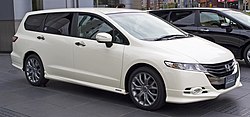Always on the lookout for places to put a cello (soon to be full-sized as the player is growing), CelloMom's eye fell on Audi's A4 Avant. Perhaps "station wagon" has too many connotations of suburbia, and "wagon" suggests something that goes way, way back in history. So, "Avant", to the future - or something like that.
However forward the name, there is plenty of space in the back for a cello, and the back row folds down flat for carrying large items. CelloMom loves the clean lines on the dashboard.In the US, the choices are limited: you can only get this car with leather seating (not that CelloMom has anything against leather seating!), and you can only get it with one engine, the 2.0L TFSI that puts out 211HP, with the quattro drive. in Germany, Audi offers the A4 with a choice of 3 gasoline engines (with and without turbo option) and 3 diesel engines. Whatever misgivings one may have about the long-term efficacy of those diesel particle filters, there is no doubt that turbocharged diesel engines put out the power at impressive fuel economy.
As an example, take a look at the 2.0L TDI turbodiesel engine (143HP): In the 6-speed manual configuration it does 39mpg in real-life driving (European sticker efficiencies are over-estimates). This is doing quite a bit better than the 24 mpg delivered by the 2.0L TFSI available in the US.
CelloMom has better news than this: for the same trim level, an A4 with the more gas-frugal 2.0L TDI (143HP) is less expensive than the same A4 with the 2.0L TFSI (211HP) engine by €3,300. The difference will be less in the US, where taxes are much lower; here the MSRP for the more frugal one is probably close to $33,000. And it would still come with leather seats. it just shows once again that cars are cheap in the US. In Germany leather seats don't come standard until you get to the "S" version. For that trim, the 2.0L TFSI quattro (211HP) version with the S-tronic transmission lists at €45,180, or about $61,200 (Sept 2011 conversion). Zoom!
In the interest of full disclosure, German Audi A4 Avants also come with a larger engine: a 3.2L FSI quattro version with Tiptronic transmission. This baby puts out 265HP, with an official fuel economy of 30mpg. Its top speed is 250kph (155mph): only good for places like Montana; the rest of us perhaps don't need something that can go well over twice the highway speed limit. On offer from €45,600 for the simplest trim.
CelloMom could easily see herself living with the German engineering, the clean-lines design, the safety record, and the attention to detail that went into this car; not to mention the space for the cello. But it would be nice if car designers would just get over their infatuation with LED lighting. In this case a line of white LEDs goes underneath each headlight, and gives the car a look that frowns, underlined with negative eyeliner. It's A Clockwork Orange with white eye makeup. The kind of thing that will make our children shudder to look back on the early LED era.
Audi A4 Avant, Same-Model comparison, different engine.
| 2.0 TFSI | 2.0 TDI | |
| Type | "Premium" | "Attraction" |
| Year | 2012 | 2012 |
| Emissions rating | EURO5 | |
| MSRP | $ 36,400 | € 33,450
($ 45,300) |
| CelloMom Rating |

|

|
| Fuel Economy: | ||
| City/Hwy quoted | 21 / 29 mpg | 6.4 / 4.5 l/100km (37 / 67 mpg) |
| Avg. quoted | 24 mpg | 5.2 l/100km (45mpg) |
| Avg. actual | 24 mpg (DOE) | 39 mpg HonestJohn |
| Engine | 2.0L TFSI quattro, |
2.0 TDI |
| Power | 211 HP | 143 HP |
| Gears | 8-spd Tiptronic | 6-spd manual |
| Fuel | premium unleaded | Diesel |
| Length, mm(in) | (185.2 in) | 4703 mm |
| Width, mm(in) | (80.3 in) | 2040 mm |
| Height, mm(in) | (56.5 in) | 1436 mm |
| Weight, kg(lbs) | (3814 lbs) | 1585 kg |
| Trunk volume, liters(cuft) | (50.5 cuft) | 490 liter |
| Turning radius, m(ft) | (37.7 ft) | 11.5 m |
| Top speed, kph(mph) | (130 mph) | 208 kph (129 mph) |







 But back to the Honday Odyssey cousins. They look similar enough, apart from slight variations in the body design. But if you go over the details you'll soon find that the Japanese cousin (pictured) is shorter by more than a foot, slimmer by about 8 inches, and less tall as well. In the US, you can buy the Odyssey only with a 3.5 liter V6 engine; in Japan it only comes with a 2.4 liter, 4-cylinder inline engine, and similarly in
But back to the Honday Odyssey cousins. They look similar enough, apart from slight variations in the body design. But if you go over the details you'll soon find that the Japanese cousin (pictured) is shorter by more than a foot, slimmer by about 8 inches, and less tall as well. In the US, you can buy the Odyssey only with a 3.5 liter V6 engine; in Japan it only comes with a 2.4 liter, 4-cylinder inline engine, and similarly in 

 This is not for CelloMom.
This is not for CelloMom. 